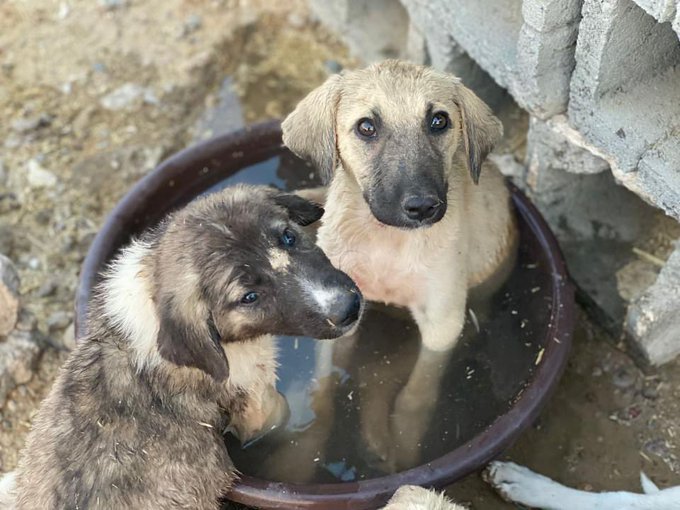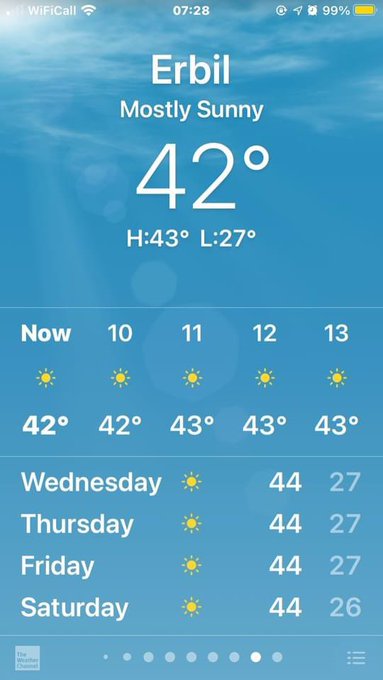To say it's a dry and hot summer would be putting it mildly. In Iraq's city of Erbil, even the puppies need relief from the heat.
And watching the coverage, it feels like we're trapped in HBO's YEARS AND YEARS. Examples? Let's start with Tuesday's ALL THINGS CONSIDERED (NPR) which aired a segment on water:
AILSA CHANG, HOST:
In the drought-stricken Klamath Basin along the California-Oregon border, water is precious. This year, Native American tribes and farmers are competing for this shrinking resource. It's an indicator of future water wars in the West. Jefferson Public Radio's Erik Neumann explains.
(SOUNDBITE OF ENGINE RUNNING)
ERIK NEUMANN, BYLINE: Biologist Alex Gonyaw aims his Boston Whaler along the eastern shore of Upper Klamath Lake. He's showing off what he says used to be abundant habitat.
ALEX GONYAW: It's a mosaic of cattails and willows and tules, or bullrushes.
NEUMANN: At almost 30 miles long, Upper Klamath Lake is home to several fish species that only live here.
GONYAW: So the more hiding places for juvenile creatures, the better they generally tend to do.
NEUMANN: Two of them are called C’waam and Koptu in the traditional Klamath Tribes' language or, in English, the lost river and shortnose sucker. Gonyaw says in recent years, the Koptu population dropped to near extinction levels from 20,000 to just 3,400 fish. The likely cause - poor water quality and habitat loss driven by low water in this shallow lake.
GONYAW: There's a catastrophic event likely in the next few years.
NEUMANN: Besides being protected under the Endangered Species Act, the fish are culturally significant to the Klamath Tribes. They've historically subsisted on them.
At a recent rally in nearby Klamath Falls, tribal chairman Don Gentry talked about how the Klamath people prayed for the fish to return after hard winters.
Water crises around the world. Melissa Montalvo (CALMATTERS) reports:
This is how California’s water crisis is going these days: The only functioning well in the rural community of Teviston broke in early June, leaving more than 700 residents without running water as temperatures in the Central Valley soared to triple-digits in a drought.
“It’s day to day” for the people of Teviston, said Frank Galaviz, a board member of the Teviston Community Services District, in an interview with The Fresno Bee.
Teviston residents are relying on limited bottled water for necessities such as staying hydrated, cooking, bathing and flushing toilets. Some residents, like Galaviz, are traveling to neighboring towns to stay with family or friends to shower and wash clothes.
Meanwhile, Kennith Lipp (NEWS TIMES) reports of Oregon:
During its regular meeting Monday, the Lincoln County Board of Commissioners declared a local disaster and drought emergency, and it asked the governor to make a similar declaration.
Last week, the board declared its first ever “drought watch,” essentially a signal that full drought status was imminent and the public should be prepared for changes in water use. Ninety percent of the American West and 99 percent of Oregon was already in some stage of drought, according the U.S. Drought Monitor.
There is no specific threshold that triggers a county drought declaration. It is based on a determination that water supplies are or soon will be low enough that typical local resources are not sufficient to respond — “extraordinary measures” will be needed to ease human suffering, environmental damage and economic losses and to respond to the threat of wildfire.
Moving to the north and to the east, Maine's WABI reports:
The South Berwick Water District has banned outdoor water use due to the worsening drought conditions.
The ban includes the use of hoses, sprinklers and irrigation systems. Washing of vehicles and the filling of swimming or wading pools is prohibited.
The water district said the outdoor water use ban is needed to help conserve water.
The district’s superintendent said the ban could last all summer depending on the conditions.
The drought has real life consequences. Some are minor -- such as banning fireworks in some areas due to the drought (in the US, July 4th is a day where people traditionally set off fireworks) and some major. impacts. Noah Wicks (AG-PULSE) reports:
North Dakota producer Mike Rott is one of thousands of farmers and ranchers across the western half of the United States struggling with drought this year, and the impact on Rott's crops is evident in field after field.
Rott's wheat is ankle-high this week at a time when, in a good year, it should be knee-high. From the road, the upper leaves of the plants appear green, hiding the brown stems and leaves — the most obvious signs of lack of moisture — below.
The junegrass in his pasture, which can grow to be 10 to 20 inches, is only about 2 to 4 inches tall at its peak month of June. Even his corn and soybeans, which are currently “doing OK” thanks to moisture from small shots of rain, are shorter than they should be.
“Some fields, you can look and you can see right down to the road all the way, and you shouldn't,” Rott, who raises cattle and farms corn, soybeans, wheat, barley and forage with his brother, told Agri-Pulse. “You shouldn't see rows at this stage of the game.”
States in the West and the High Plains are currently facing what Brad Rippey, a USDA meteorologist in the Office of the Chief Economist, calls the “most expansive” drought the U.S. has seen since 2012 and 2013.
“We're looking at now almost a year of drier than normal conditions that sapped, not just topsoil moisture, but subsoil moisture with really dire impacts on rangeland, and pastures, and then eventually winter grains and now spring zone crops,” Rippey said.
And Tara Lohan (THE REVELATOR) notes:
Extreme drought conditions gripping the West have stirred familiar struggles over water in the Klamath Basin, which straddles the Oregon-California border. Even in a good year, there’s often not enough water to keep ecosystems healthy and farms green — and this year is anything but good.
For the past two decades critics have simplistically reduced water woes in the basin to “fish vs. farms” in the battle for an increasingly scarce resource. This year, which is expected to be the lowest water year on record, it’s clear there aren’t any winners.
The Bureau of Reclamation, a Department of the Interior agency that oversees water resources in the West, has already shut the tap on irrigation water for farms in the area in order to maintain water levels in Klamath Lake needed to protect endangered suckers. It also halted releases into the Klamath River that help keep fish healthy. Following that, high temperatures and low flows fed an outbreak of the parasite Ceratonova shasta, causing a massive die-off of hundreds of thousands of juvenile salmon this past spring.
And another dire casualty hovers in the wings — birds.
Millions of birds migrate through the basin each year, relying on a complex of wildlife refuges that are quickly running dry. Last year drought conditions forced too many birds into too small a space, and 60,000 perished of avian botulism that spread quickly in close quarters.
Experts predict this year will be worse, and the problems could extend south to California’s Central Valley. Both places are critical stops on the Pacific Flyway, used by more than 320 bird species to feed and rest as they travel up and down the west coasts of North and South America.
A climate crisis. That's what we're in the midst of. And we've got a government that not only unprepared but also unaware.


